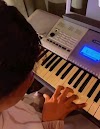#learn sheet music part5: Understanding and Playing the Quaver (Eighth Note)
#### What is a Quaver?
A quaver (British terminology) or eighth note (American terminology) is a note that typically receives half a beat in common time (4/4 time signature). It's represented by a filled-in note head with a straight stem and a single flag, as shown in the image.
#### Counting and Timing
In a 4/4 time signature, each measure consists of four beats, and each quaver gets half a beat. When counting, you would say "1 and 2 and 3 and 4 and," with each number and the word "and" representing a quaver.
#### How to Play a Quaver on the Piano
1. **Identify the Note**: Determine which note you'll be playing. Let's start with middle C.
2. **Posture and Hand Position**: Sit comfortably at the piano with your fingers curved and your thumb resting on middle C.
3. **Counting Out Loud**: Begin by counting "1 and 2 and 3 and 4 and" aloud to establish a steady rhythm.
4. **Press the Key**: On each count (both numbers and "ands"), press the middle C key firmly and release it quickly, preparing to press it again on the next count.
#### Practicing with Metronome
Using a metronome can help maintain a consistent tempo:
1. Set the metronome to a slow tempo, such as 60 BPM (beats per minute).
2. Play middle C in time with the metronome, pressing the key on each beat and each "and."
#### Exercises
1. **Single Note Practice**: Play middle C for eight quavers (1 and 2 and 3 and 4 and), then rest for four beats. Repeat this several times.
2. **Alternating Notes Practice**: Play a series of quavers starting from middle C, alternating with D (C-D-C-D) for eight counts, timing each note to half a beat.
3. **Simple Songs**: Practice simple songs or scales using quavers to get comfortable with the rhythm.
#### Why Quavers Matter
Quavers add a level of rhythmic complexity and interest to music. They allow for faster passages and more intricate rhythmic patterns, essential for developing advanced piano playing skills.
#### Conclusion
Mastering quavers is a crucial step in becoming a well-rounded pianist. By practicing with this tutorial, you'll improve your rhythm, timing, and overall musicality. Keep practicing, and you'll soon integrate quavers seamlessly into your playing.
Share this tutorial with three friends or groups who are learning piano, and follow Vicpiano for more piano tutorials and tips! Happy playing! 🎶










0 Comments